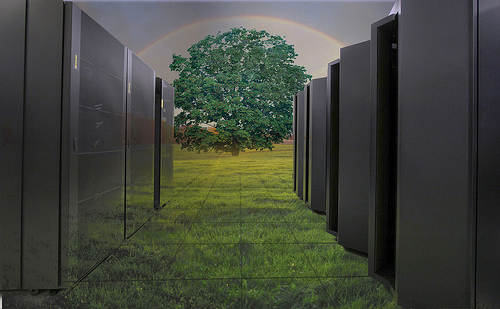 Big Blue is rolling out a wide range of “green” services, including research into a new generation of batteries that could double the range of electric vehicles.Courtesy IBMBack in the day when I had to convince East Coast editors that green tech wasn’t some crunchy California fad but Big Business, I often cited IBM as Exhibit A that Fortune 500 companies saw a lot of green to be made in green.
Big Blue is rolling out a wide range of “green” services, including research into a new generation of batteries that could double the range of electric vehicles.Courtesy IBMBack in the day when I had to convince East Coast editors that green tech wasn’t some crunchy California fad but Big Business, I often cited IBM as Exhibit A that Fortune 500 companies saw a lot of green to be made in green.
Over the past several years, Big Blue has been recycling and repurposing a panoply of technologies to create a portfolio of environmental services — everything from a traffic congestion pricing system in Stockholm to a smart water and electricity grid for Malta.
I recently ran into C. Spike Narayan, manager of science and technology at IBM’s Almaden Research Center, at one of those green business dinner gatherings held with some frequency at various upscale San Francisco restaurants. He mentioned that his Silicon Valley lab was working on a new battery technology with the potential to extend the range of electric cars to more than 400 miles per charge and make it possible to use the batteries to store electricity generated by solar power plants and wind farms.
Narayan wouldn’t say much more than that at the time. Last week, however, I headed back into the city for another green tech dinner — put on by IBM — where details of the battery project were provided, as well as other new Big Green initiatives from Big Blue.
IBM hopes to exploit its expertise in supercomputing, nanotechnology, green chemistry and materials science to develop lithium-air technology. As Narayan explained it me, such batteries could pack 10 times the energy density of the lithium ion batteries now used in electric cars because they use air drawn in from outside the battery as a reactant. That means lithium-air storage devices weigh less than lithium-ion batteries, which also improves performance of electric cars. It’s not a new idea, but no one has yet created a rechargeable lithium air battery.
If lithium air proves feasible and cost-effective, it could ice the ICE (internal combustion engine) and turn intermittent renewable energy sources into 24/7 power plants. The net-zero home could become a reality with solar panels on the roof and a bank of lithium air batteries in the basement to provide power when the sun isn’t shining.
But the technological challenges are immense, which is why only a few startups and the U.S. Department of Defense have attempted to tackle lithium air.
First, you have to figure out how to strip the water from the air before it enters the battery. “You need a membrane technology that can carefully transport only oxygen extremely well while excluding everything else,” says Narayan.
That’s where IBM’s long-time work on membranes for desalinization plants comes into play. Given that the lithium air reaction deposits layers of lithium oxide on the membrane, IBM will need to manipulate materials on the nano level to keep the batteries functioning. Researchers will tap Big Blue supercomputers to model the performance of various potential catalysts for the lithium air reaction.
Even IBM can’t do this alone, however, and the company is seeking to form an alliance with universities and government laboratories. “We have no desire to make batteries,” says Rich Lechner, IBM’s vice president for energy and the environment. “We will license” the intellectual property.
Adds Narayan: “This is a five to 10 year project. The first phase is to go after the big science problems. Then we’re ready to engage with automotive companies and battery manufacturers.”
(The news comes as the U.S. Department of Energy announced it would loan nearly $8 billion to Ford, Nissan and Silicon Valley electric car startup Tesla Motors to develop electric cars and battery manufacturing capacity.)
Another IBM green tech development that could have significant impact in our data-dependent global economy: The company has built a new supercomputer called the Aquasar at the Swiss Federal Institute of Technology Zurich that water-cools not just each rack of servers but each individual processor. The waste heat is then used to heat the building during the cold Swiss winter. The result: a 40 percent cut in energy consumption.
And in another sign that tackling corporate America’s CO2 addiction is too big for even a tech behemoth, IBM unveiled Green Sigma — a new alliance with erstwhile competitors like software giant SAP and networking kingpin Cisco, along with Johnson Controls and Honeywell, that will cooperatively devise solutions for reducing companies’ carbon footprints.
Green Sigma … gotta be a cartoon superhero spinoff in there somewhere.
—
Below: An IBM video about the Aquasar supercomputer.
Read past Green State columns by Todd Woody.


